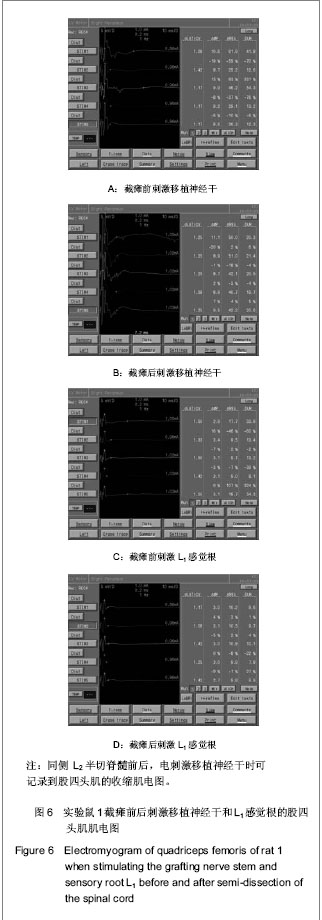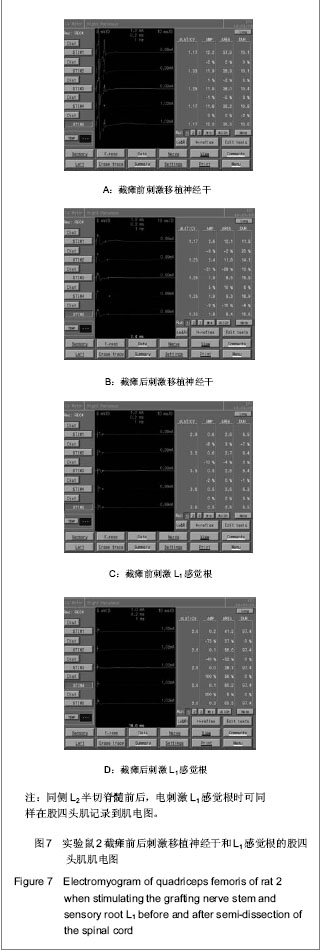| [1] Zhang SC, Qu CY, Zhang XS, et al. Zhonghua Miniao Waike Zazhi. 2001;22(4):220-222.张少成,瞿创予,张雪松,等. 神经移植术治疗截瘫神经性膀胱的尿动力学观察[J]. 中华泌尿外科杂志, 2001,22(4): 220-222.http://www.cnki.com.cn/Article/CJFDTotal-ZHMN200104013.htm[2] Xiao CG, Du MX, Li B, et al. An artificial somatic-autonomic reflex pathway procedure for bladder control in children with spina bifida. J Urol. 2005;173(6):1850-1851.http://www.ncbi.nlm.nih.gov/pubmed/15879861[3] Gu YD. Shanghai: Shanghai Medical Universty Press. 1992.顾玉东.臂丛神经损伤与疾病的诊治[M].上海:上海医科大学出版社,1992.http://www.fudanpress.com/root/showdetail.asp?bookid=2069[4] Zhang SC, Xu SG, Ma YH, et al. Shanghai Dier Junyi Daxue Xuebao. 2004;7(4):803-804.张少成,许硕贵,马玉海,等. 硬脊膜内松解自体周围神经植入治疗脊髓陈旧性不完全性断裂伤[J].上海第二军医大学学报, 2004,7(4):803-804.http://www.39kf.com/cooperate/qk/ORTHOPEDIC-JOURNAL-OF-CHINA/0920/2010-01-13-629768.shtml[5] Dam-Hieu P, Liu S, Choudhri T, et al. Regeneration of primary sensory axons into the adult rat spinal cord via a peripheral nerve graft bridging the lumbar dorsal roots to the dorsal column. J Neurosci Res. 2002;68(3):293-304.http://www.ncbi.nlm.nih.gov/pubmed/12111859[6] Golden KL, Pearse DD, Blits B,et al. Transduced Schwann cells promote axon growth and myelination after spinal cord injury. Exp Neurol. 2007;207(2):203-217.http://www.ncbi.nlm.nih.gov/pubmed/17719577[7] Park IH, Zhao R, West JA, et al. Reprogramming of human somatic cells to pluripotency with defined factors. Nature. 2008;451(7175):141-146.http://www.ncbi.nlm.nih.gov/pubmed/23260147[8] Eftekharpour E, Karimi-Abdolrezaee S, Wang J, et al. Myelination of congenitally dysmyelinated spinal cord axons by adult neural precursor cells results in formation of nodes of Ranvier and improved axonal conduction. J Neurosci. 2007; 27(13):3416-3428.http://www.ncbi.nlm.nih.gov/pubmed/17392458[9] Sun Q, Zheng J, Zhao C. Nerve transplantation and accompanying peripheral vessels for repair of long nerve defect. Zhongguo Xiufu Chongjian Waike Zazhi. 2012;26(7): 832-836.http://www.ncbi.nlm.nih.gov/pubmed/22905621[10] Xia L, Hao SY, Li DZ, et al. Zhongguo Zuzhi Gongcheng Yanjiu. 2012;16(47):821-8825.夏雷,郝淑煜,李德志,等. 种植神经干细胞-许旺细胞的共聚物支架移植修复大鼠损伤脊髓[J]. 中国组织工程研究, 2012,16(47): 821-8825.http://www.cnki.com.cn/Article/CJFDTotal-XDKF201247025.htm[11] Kan R, Sheng WB. Zhongguo Zuzhi Gongcheng Yanjiu. 2013; 17(3):501-508.阚瑞,盛伟斌. 人工合成高分子支架材料治疗脊髓损伤[J]. 中国组织工程研究,2013,17(3):501-508.http://www.cqvip.com/Read/Read.aspx?id=45155203[12] Chen X, Yu ZJ. Jujie Shoushuxue Zazhi. 2013;21(2):199-201.陈祥,余资江. 电针与骨髓问充质干细胞移植在脊髓损伤修复及再生中的作用[J]. 局解手术学杂志,2013,21(2):199-201.http://www.cqvip.com/QK/97466X/201302/45280624.html[13] Yin H, Re XJ, Jiang T., et al. Zhonghua Chuangshang Zazhi. 2013;9(3):278-283.阴洪,任先军,蒋涛,等.超声辅助脱细胞脊髓支架的生物学特性研究[J]. 中华创伤杂志,2013,29(3):278-283.http://www.cnki.com.cn/Article/CJFDTotal-SWGK200804003.htm[14] Wei XK, Wen YM, Zhang T, et al. Zhonguo Xiufu Chongjian Waike Zazhi. 2012;26(11):1362-1368.魏祥科,文益民,张涛,等. BMSCs联合去细胞肌肉生物支架修复大鼠脊髓半切损伤的实验研究[J]. 中国修复重建外科杂志, 2012, 26(11):1362-1368.http://www.cnki.com.cn/Article/CJFDTotal-ZXCW201211030.htm[15] Wang D,Fan YH,Zhang JJ,et al. Transplantation of Nogo-66 receptor gene-silencecl cells in a poly(D,L-lactic-co-glycolic acid) scaffoldfor the treatment of spinal cord injur. Neural Regeneration Research. 2013,8(8):677-685.http://d.wanfangdata.com.cn/Periodical_zgsjzsyj-e201308001.aspx[16] Li N,Liu B, Rong LM, et al. Zhonghua Chuangshang Guke Zazhi. 2012;14(3):241-245.李宁,刘斌,戎利民,等. 静电纺丝聚乳酸聚乙醇酸/聚乙二醇纳米纤维作为组织工程支架的体外细胞相容性研究[J]. 中华创伤骨科杂志,2012,14(3):241-245.http://d.wanfangdata.com.cn/Periodical_zhcsgkzz201203014.aspx[17] Guérout N, Paviot A, Bon-Mardion N, et a1.Co-transplantation of olfactory ensheathing cells from mucosa and bulb origin enhances functional recovery after peripheral nerve lesion. PLoS One. 2011;6(8):e22816. http://www.docin.com/p-342712149.html[18] Gu SH, Xu WD, Xu L, et a1.Regenerated host axons form synapses with neurons derived from neural stem cells transplanted into peripheral nerves. J Int Med Res. 2010; 38(5): 1721-1729.http://www.ncbi.nlm.nih.gov/pubmed/21309486[19] Yu P, Huang L, Zou J, et al. Immunization with recombinant Nogo-66 receptor (NgR) promotes axonal regeneration and recovery of function after spinal cord injury in rats. Neurobiol Dis. 2008;32(3):535-542.http://www.ncbi.nlm.nih.gov/pubmed/18930141[20] Nouhaud FX, Caremel R, Leroi AM, et al. Bladder reinnervation with creation of a "somato-autonomic" reflex pathway in spinal cord injured or spina bifida, a new way for treatment?. Prog Urol. 2011;21(8):501-507.http://www.ncbi.nlm.nih.gov/pubmed/21872150[21] Liu S, Blanchard S, Bigou S, et a1.Neurotrophin 3 improves delayed reconstruction of sensory pathways after cervical dorsal root injury. Neurosurgery. 2011;68(2):450-461.http://www.ncbi.nlm.nih.gov/pubmed/21135740[22] Lin H, Hou C, Chen A, et al. Reinnervation of atonic bladder after conus medullaris injury using a modified nerve crossover technique in canines. World Neurosurg. 2010;73(5):582-586.http://www.ncbi.nlm.nih.gov/pubmed/20920947[23] Liu S, Bohl D, Blanchard S, et al. Combination of microsurgery and gene therapy for spinal dorsal root injury repair. Mol Ther. 2009n;17(6):992-1002.http://www.ncbi.nlm.nih.gov/pubmed/19240691[24] Dam-Hieu P, Liu S, Tadié M. Experimental bypass surgery between the spinal cord and caudal nerve roots for spinal cord injuries. Neurochirurgie. 2004;50(5):500-514.http://www.ncbi.nlm.nih.gov/pubmed/15654303[25] Ando T, Sato S, Toyooka T, et al. Photomechanical Wave-Driven Delivery of siRNAs Targeting Intermediate Filament Proteins Promotes Functional Recovery after Spinal Cord Injury in Rats. PLoS One. 2012;7(12):e51744.http://www.ncbi.nlm.nih.gov/pubmed/23272155[26] Fawatt J.Repair of spinal cord injuries:where we are,where are we going.Spinal cord. 2002;40(2):615-623.http://www.ncbi.nlm.nih.gov/pubmed/12483491[27] Bregman BS, Kunkel-Bagden E, Schnell L, et al. Recovery from spinal cord injury mediated by antibodies to neurite growth inhibitors. Nature. 1995;378(6556):498-501.http://www.ncbi.nlm.nih.gov/pubmed/7477407[28] Ferguson AR, Huie JR, Crown ED, et al. Central nociceptive sensitization vs. spinal cord training: opposing forms of plasticity that dictate function after complete spinal cord injury. Front Physiol. 2012;3:396.http://www.ncbi.nlm.nih.gov/pubmed/23060820[29] Yang YL. Effect of adenovirus-mediated basic fibroblast growth factor gene transfer in vivo on oligodendrocyte cell numbers throughout ventrolateral white matter following spinal cord injury in rats. Zhongguo Yi Xue Ke Xue Yuan Xue Bao. 2012;34(4):348-352.http://www.ncbi.nlm.nih.gov/pubmed/22954116 |



.jpg)
.jpg)
.jpg)
.jpg)
.jpg)